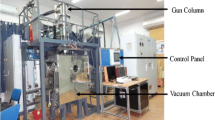Abstract
This paper presents a study on the optimisation control of a reactive polymer composite moulding process using ant colony optimisation and bootstrap aggregated neural networks. In order to overcome the difficulties in developing accurate mechanistic models for reactive polymer composite moulding processes, neural network models are developed from process operation data. Bootstrap aggregated neural networks are used to enhance model prediction accuracy and reliability. Ant colony optimisation is able to cope with optimisation problems with multiple local optima and is able to find the global optimum. Ant colony optimisation is used in this study to find the optimal curing temperature profile. In order to enhance the reliability of the optimisation control policy, model prediction confidence bound offered by bootstrap aggregated neural networks is incorporated in the optimisation objective function so that unreliable predictions are penalised. The proposed method is tested on a simulated reactive polymer composite moulding process.





Similar content being viewed by others
References
Pantelelis NG (2005) Towards the dynamic optimisation for the cure control of thermoset-matrix composite materials. Compos Sci Technol 65:1254–1263
Cybenko G (1989) Approximation by superposition of a sigmoidal function. Math Control Signal Syst 2:303–314
Bhat NV, McAvoy TJ (1990) Use of neural nets for dynamical modelling and control of chemical process systems. Comput Chem Eng 14:573–583
Bulsari AB (ed) (1995) Computer-aided chemical engineering, vol 6, Neural Networks for Chemical Engineers. Elsevier, Amsterdam
Bishop C (1991) Improving the generalisation properties of radial basis function neural networks. Neural Comput 13:579–588
Bishop C (1995) Neural networks for pattern recognition. Oxford University Press, Oxford
MacKay DJC (1992) Bayesian interpolation. Neural Comput 4:415–447
Sridhar DV, Seagrave RC, Bartlett EB (1996) Process modelling using stacked neural networks. AIChE J 42:2529–2539
Wolpert DH (1992) Stacked generalization. Neural Netw 5:241–259
Zhang J, Morris AJ, Martin EB, Kiparissides C (1997) Inferential estimation of polymer quality using stacked neural networks. Comput Chem Eng 21:s1025–s1030
Breiman L (1996) Bagging predictor. Mach Learn 24:123–140
Zhang J (1999) Developing robust non-linear models through bootstrap aggregated neural networks. Neurocomputing 25:93–113
Sattlecker M, Baker R, Stone N, Bessant C (2011) Support vector machine ensembles for breast cancer type prediction from mid-FTIR micro-calcification spectra. Chemom Intell Lab Syst 107:363–370
Chen T, Ren J (2009) Bagging for Gaussian process regression. Neurocomputing 72:1605–1610
Goldberg DE (1989) Genetic algorithms in search, optimisation and machine learning. Addison-Wesley Publishing Company, Reading, MA
Kennedy J, Eberhart R (1995) Particle swarm optimization. In Proceedings of the 1995 IEEE international conference on neural networks, vol 6, Perth, Australia, 1942–1948
Dorigo M, Gambardella LM (1997) Ant colonies for the travelling salesman problem. Biosystems 43:73–81
Bilchev G, Parmee IC (1995) The ant colony metaphor for searching continuous design spaces. Lect Notes Comput Sci 993:25–39
Bilchev G, Parmee IC (1996) Constrained optimisation with an ant colony search model. In: Proceedings of the ACEDC, pp 145–151
Wodrich M, Bilchev G (1997) Cooperative distributed search: the ants’ way. Control Cybern 26(3):413–441
Mathur M, Karale SB, Priye S, Jayaraman VK, Kulkarni BD (2000) Ant colony approach to continuous function optimization. Ind Eng Chem Res 39(10):3814–3822
Ahmad Z, Zhang J (2005) Bayesian selective combination of multiple neural networks for improving long range predictions in nonlinear process modeling. Neural Comput Appl 14:78–87
Ahmad Z, Zhang J (2006) Combination of multiple neural networks using data fusion techniques for enhanced nonlinear process modeling. Comput Chem Eng 30:295–308
Efron B (1982) The jackknife, the bootstrap and other resampling plans. Society for Industrial and Applied Mathematics, Philadelphia
Zhang J (2004) A reliable neural network model based optimal control strategy for a batch polymerization reactor. Ind Eng Chem Res 43(4):1030–1038
Mukherjee A, Zhang J (2008) A reliable multi-objective control strategy for batch processes based on bootstrap aggregated neural network models. J Process Control 18:720–734
Socha K, Dorigo M (2008) Ant colony optimization for continuous domains. Eur J Oper Res 185(3):1155–1173
Acknowledgments
The work is supported by the EU through the project iREMO—intelligent reactive polymer composite moulding (Grant No. NMP2-SL-2009-228662). The authors thank Dr Nikos G. Pantelelis from National Technical University of Athens for providing the simulation programme.
Author information
Authors and Affiliations
Corresponding author
Rights and permissions
About this article
Cite this article
Mohammed, KJ.R., Zhang, J. Reliable optimisation control of a reactive polymer composite moulding process using ant colony optimisation and bootstrap aggregated neural networks. Neural Comput & Applic 23, 1891–1898 (2013). https://doi.org/10.1007/s00521-012-1273-y
Received:
Accepted:
Published:
Issue Date:
DOI: https://doi.org/10.1007/s00521-012-1273-y




